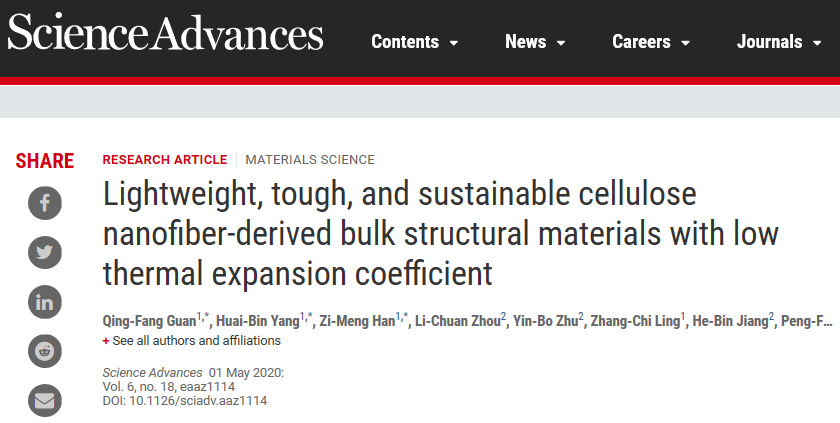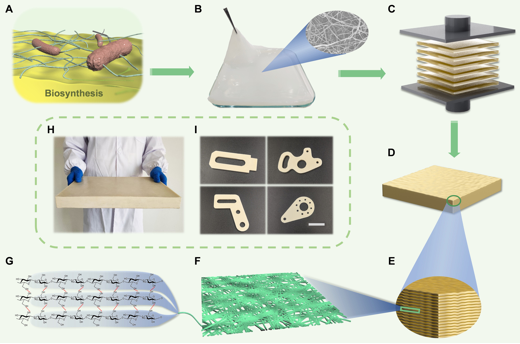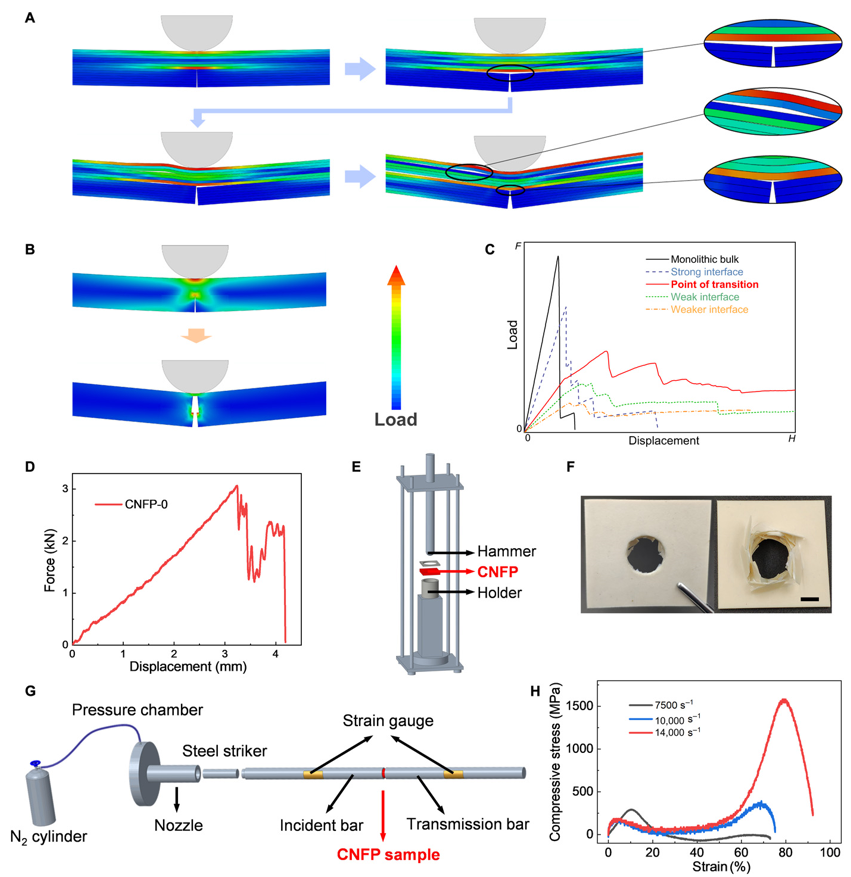Significant progress has been made in the development of a new type of nano-cellulose high-performance bionic structural material of China University of Science and Technology
QQ Academic Group: 1092348845
Detailed
Materials are the material basis for the development of human civilization. Aerospace and other high-tech fields continue to raise new requirements for the improvement of the performance of engineering structural materials. The development of new lightweight and high-strength materials that fully surpass traditional structural materials such as engineering plastics, ceramics and metal materials has an important strategy for practical applications in related fields Significance, it will have broad application prospects in application fields such as lightweight impact protection and cushioning materials, space materials, and precision instrument structural parts.

Recently, the team of Academician Yu Shuhong of the University of Science and Technology of China has developed a new type of nanofiber bionic structural material manufacturing method, and successfully developed a class of natural nanocellulose high-performance structural materials (hereinafter referred to as CNFP). CNFP has excellent comprehensive properties, the density is only one-sixth that of steel, and the specific strength and specific toughness are higher than traditional alloy materials, ceramics and engineering plastics. This new type of bionic bionic structural material is expected to replace existing engineering plastics , Has a wide range of application prospects. Relevant research results were recently published in Science Advances (Science Advances 2020, 6, eaaz1114) under the title "Lightweight, tough, and sustainable cellulose nanofiber-derived bulk structural materials with low thermal expansion coefficient". The co-first authors of the thesis are Guan Qingfang, postdoctoral fellow at Hefei National Research Center for Microscale Material Science, and master students Yang Huaibin and Han Zimeng.

Figure 1. The preparation process, structure diagram, sample photos and processability display of cellulose nanofiber structure material (CNFP). (A) Large-scale cellulose nanofiber hydrogels can be synthesized by microorganisms at low cost under normal temperature and pressure; (B) The hydrogel and its three-dimensional nanofiber network structure are shown in the figure. (C) CNFP is prepared by layer-by-layer assembly and compression of hydrogel. (D) Schematic diagram of CNFP sample; (E) Multi-layer structure of CNFP. (F) CNFP single-layer structure is composed of a network formed by a large number of nanofibers; (G) each nanofiber in CNFP is assembled by highly oriented cellulose molecules; (H-I) CNFP samples and processed parts photos.
This new type of CNFP bionic structural material has extremely high-scale stability, with a thermal expansion coefficient as low as 5 ppm K-1, which is far superior to traditional alloy materials and engineering plastics, and is close to ceramics. Under severe thermal shock conditions, the mechanical properties and dimensions of the material are still highly stable. In addition, CNFP also has extremely high impact resistance, high damage tolerance and energy absorption performance.

Figure 2. Ashby diagram of CNFP and various engineering materials thermal expansion coefficient, specific strength and specific impact toughness. (A) Thermal expansion coefficient and specific strength Ashby diagram, indicating that CNFP has better specific strength and thermal expansion coefficient than traditional alloys, engineering plastics and ceramics. (B) Thermal expansion coefficient and specific impact toughness Ashby diagram, indicating that CNFP has better specific toughness and thermal expansion coefficient than traditional alloys, engineering plastics and ceramics.
The research results show that CNFP has excellent properties of light weight, high strength and toughness. Its specific strength and specific impact toughness have reached 198 MPa/(Mg m-3) and 67 kJ m-2/(Mg m-3), respectively, which surpass aviation Aluminum alloy and steel, and its density is as low as 1.35 g cm-3, which is only one-sixth of steel and half of aluminum alloy (Figure 2). The researchers found that the lightweight, high-strength and toughness of this CNFP mainly comes from the material‘s micron-level layered structure and nano three-dimensional network structure design. The high crystallinity inside the cellulose nanofiber can provide extremely high strength, and the fibers are reversible through a large number of hydrogen bonds. The interaction network is combined. Under the action of external force, this high-density reversible interaction network can quickly dissociate and reconstruct, absorb a large amount of energy, so that the material has high strength while achieving high toughness, which overcomes the difficulty of traditional structural materials. The problem of high strength and high toughness.

Figure 3. The excellent thermo-mechanical properties of CNFP. (A) Thermal expansion of CNFP (parallel to the layer), polyamide (PA), aluminum alloy (7075 Al), and Al2O3. (B) Comparison of bending strength and stiffness of different types of CNFPs. (C) Comparison of the Charpy impact toughness of CNFP-0 with other widely used polymer materials. (D) The bending stress-strain curve of CNFP-0 at different temperatures. (E and F) Comparison of CNFP-0 and other widely used polymer-based materials at (E) 30°C and (F) 200°C. (G) Schematic diagram of 10 times rapid thermal shock. (H) The bending stress-strain curve of CNFP-0 before and after 10 rapid thermal shocks. Methacrylic acid, polymethyl methacrylate; PVC polyvinyl chloride; ABS, acrylonitrile, butadiene, styrene; PC, PC (polycarbonate) plastic; PF, phenolic resin; POM polyoxymethylene; PP, polypropylene.
CNFP also has extremely high dimensional stability and thermal shock resistance. In the temperature range of -120°C to 150°C, the thermal expansion coefficient of CNFP is as low as (5 ppm K-1), that is, the temperature change is 100°C, and the size change is within five ten thousandths, which is far better than aviation alloy materials And engineering plastics, only one-fifth of aviation aluminum alloy, and one-tenth of engineering plastics, which is close to ceramics. In addition, the mechanical properties and dimensions of CNFP are still highly stable under repeated severe thermal shock cycles between 120°C and -196°C. At the same time, due to the high crystallinity and high chemical stability of nanofibers, CNFP has a good service capability under extreme conditions.

Figure 4. CNFP‘s excellent toughness mechanism and impact resistance. (A and B) Finite element simulation of laminated structure and (B) monolithic block for SENB testing. (C) Stress-strain curves of different interfaces in SENB test. (D) Force-displacement curve of CNFP-0 in drop weight impact test. (E) Schematic diagram of falling weight impact testing machine. (F) Photograph of CNFP-0 after falling weight impact test. Scale bar, 1 cm. (G) Small house planning outline. (H) Compressive stress-strain curve of SHPB test CNFP-0 under different strain rates.
In addition, CNFP also has extremely high impact resistance, high damage tolerance and high energy absorption performance. The ultra-high-speed impact test results of the split Hopkinson pressure bar show that CNFP exhibits an ultra-high compressive strength of 1600MPa under a high-speed impact of 28 m s-1 (equivalent to a high-speed car), at 0.07 ms It can absorb impact energy up to 387.5 MJ m-3 inside. This is mainly because the inherent three-dimensional nanofiber network of CNFP slips when subjected to high-speed impact, and the large number of hydrogen bonds between nanofibers are rapidly dissociated and reconstructed, which can absorb and convert impact kinetic energy into heat, which is expected to make it possible As a substitute for alloys.
This sustainable new type of natural nanofiber bionic structural material integrates a variety of excellent properties such as light weight, high strength, high dimensional stability, thermal shock resistance, impact resistance, and high damage tolerance. It has outstanding comprehensive performance and will be used in lightweight and impact resistance. Application fields such as protective and cushioning materials, space materials, and precision instrument structural parts will have broad application prospects.
This research was funded by the National Natural Science Foundation of China‘s Innovative Research Group, the National Natural Science Foundation of China‘s key projects, the Chinese Academy of Sciences‘ Frontier Science Key Research Projects, the Chinese Academy of Sciences‘ Nanoscience Excellence Innovation Center, and the Hefei Comprehensive National Science Center.
Source Organized in the University of Science and Technology of China
Paper link:
https://advances.sciencemag.org/content/6/18/eaaz1114
This information is sourced from the Internet for academic exchange only. If there is any infringement, please contact us to delete it immediately.
- Previous: The latest achievement
- Next: A Rising 2D Star: Nove


 Academic Frontier
Academic Frontier